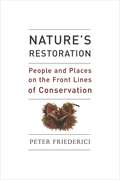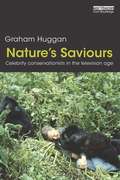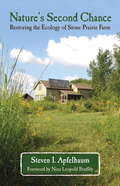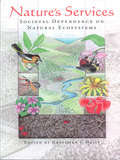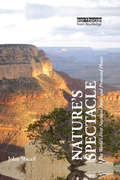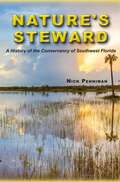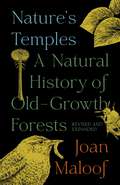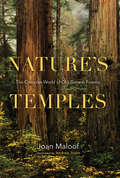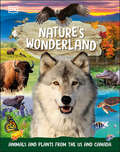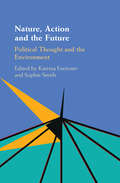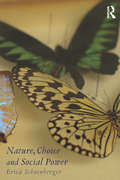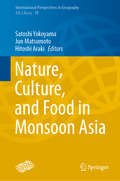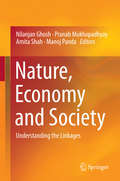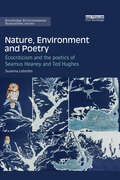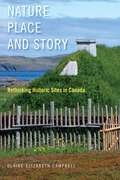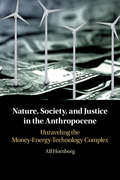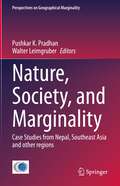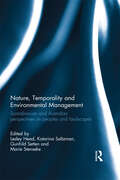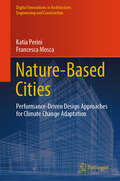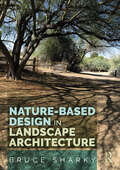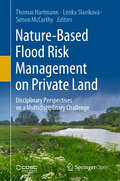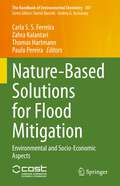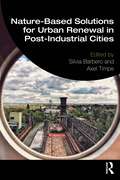- Table View
- List View
Nature's Restoration: People and Places on the Front Lines of Conservation
by Peter FriedericiAcross America and around the world, people areworking to help nature heal itself. In Bermuda, a mansingle-handedly grows thousands of trees on a smallisland to restore nesting habitat for a rare seabird. InIllinois, legions of volunteers replant prairies in theshadows of freeways. In Virginia, a farmer works tobring back the mighty American chestnut.What drives these individuals? How did their passionscome about, and what are the implications forrestoring the environment? Nature"s Restoration: People and Places on theFront Lines of Conservation is a lyrical look at these and other examplesof ordinary citizens aiming to return sizable tracts of the Americanlandscape to nature, and to health. They"ve found success in preservingrare species, reversing negative ecological trends, and promotinggreater intimacy with nature.Yet the work is far from simple. Restoration projects are often in thenews not only because of the promise they hold, but also because ofthe controversy they provoke. Based on detailed reporting and numerousinterviews, Nature"s Restoration puts us on the front lines ofrestoration to learn how this burgeoning national movement shapesboth places and people.
Nature's Saviours: Celebrity Conservationists in the Television Age
by Graham HugganToday's celebrity conservationists, many of whom made their reputations through television and other visual media, play a major role in drawing public attention to an increasingly threatened world. This book, one of the first to address this contribution, focuses on five key figures: the English naturalist David Attenborough, the French marine adventurer Jacques-Yves Cousteau, the American primatologist Dian Fossey, the Canadian scientist-broadcaster-activist David Suzuki, and the Australian 'crocodile hunter' Steve Irwin. Some of the issues the author addresses include: What is the changing relationship between western conservation and celebrity? How has the spread of television helped shape and mediate this relationship? To what extent can celebrity conservation be seen as part of a global system in which conservation, like celebrity, is big business? The book critically examines the heroic status accorded to the five figures mentioned above, taking in the various discourses – around nature, science, nation, gender – through which they and their work have been presented to us. In doing so, it fills in the cultural, historical and ideological background behind contemporary celebrity conservationism as a popular expression of a chronically endangered world.
Nature's Second Chance: Restoring the Ecology of Stone Prairie Farm
by Steven I. ApfelbaumRenowned conservationist Aldo Leopold once wrote, "A thing is right when it tends to preserve the integrity, stability, and beauty of the biotic community. It is wrong when it does otherwise. "Few have taken Leopold’s vision more to heart than Steven I. Apfelbaum, who has, over the last thirty years, transformed his eighty-acre Stone Prairie Farm in Wisconsin into a biologically diverse ecosystem of prairie, wetland, spring-fed brook, and savanna. In healing his land, Apfelbaum demonstrates how humans might play a starring role in healing the planet.
Nature's Services: Societal Dependence On Natural Ecosystems
by Stephen Carpenter Gretchen Daily Les Kaufman Kamaljit Bawa Charles H. Peterson Sandra PostelLife itself as well as the entire human economy depends on goods and services provided by earth's natural systems. The processes of cleansing, recycling, and renewal, along with goods such as seafood, forage, and timber, are worth many trillions of dollars annually, and nothing could live without them. Yet growing human impacts on the environment are profoundly disrupting the functioning of natural systems and imperiling the delivery of these services.Nature's Services brings together world-renowned scientists from a variety of disciplines to examine the character and value of ecosystem services, the damage that has been done to them, and the consequent implications for human society. Contributors including Paul R. Ehrlich, Donald Kennedy, Pamela A. Matson, Robert Costanza, Gary Paul Nabhan, Jane Lubchenco, Sandra Postel, and Norman Myers present a detailed synthesis of our current understanding of a suite of ecosystem services and a preliminary assessment of their economic value. Chapters consider: major services including climate regulation, soil fertility, pollination, and pest control philosophical and economic issues of valuation case studies of specific ecosystems and services implication of recent findings and steps that must be taken to address the most pressing concerns Nature's Services represents one of the first efforts by scientists to provide an overview of the many benefits and services that nature offers to people and the extent to which we are all vitally dependent on those services. The book enhances our understanding of the value of the natural systems that surround us and can play an essential role in encouraging greater efforts to protect the earth's basic life-support systems before it is too late.
Nature's Spectacle: The World's First National Parks and Protected Places
by John SheailNational parks have always been an emotive and iconic symbol, ever since the first parks of the modern era were created in the mid-nineteenth century. This book, based on original research, delves deeply into their character and significance, and the larger context in which they developed. The book celebrates the deserved attractiveness of the parks as wilderness or 'spectacle' to millions of visitors, but also emphasises how there was nothing inevitable, self-sustaining or without cost in their magnificence and accessibility. Those early parks were a powerful unifying force as national 'playgrounds', especially as motor transport democratised their use. However they also provoked bitter conflict in their dispossession of local communities and perhaps deliberate segregation of people from scenery and wildlife. That first century of national parks, which concluded with the significant break of the Second World War and the subsequent development of more international approaches to conservation, left an uncertain legacy. It was a fragile foundation from which to build what became an integral part of today's conservation movement.
Nature's Steward: A History of the Conservancy of Southwest Florida
by Nick PennimanNature's Steward chronicles the development of southwest Florida using the modern-day Conservancy of Southwest Florida as the lens through which to examine environmental history. A parallel track exists alongside the Conservancy's story, and that is the evolution of land acquisition practices and comprehensive growth management planning efforts at the state and federal levels. The reader will come to understand the enormous commitment of time and money required to ensure that a beautiful corner of the world be developed in a generally sensible manner. The book is organized chronologically with three separate topics: land acquisition, managing for growth, and water. Each chapter focuses on events ranging from specific developments like Marco Island to broader initiatives such as the Collier County Rural Lands Stewardship Program, allowing the reader to appreciate the number of years spent working through the nuances, twists, turns, setbacks, and triumphs encountered in steering growth into landscapes best suited for development. This book also intends to sound an alarm. While most development has been carefully directed since the 1970s, water has long been overlooked as a finite resource in building out coastal Collier and Lee Counties. Further inland, extraction industries and creeping urban sprawl are responsible for habitat fragmentation that imperils a dozen threatened and endangered birds and mammals including the iconic Florida panther. And, finally, the prevailing paradigm in Tallahassee has pitched forty years of evolved environmental protection and regulation right out the window. This history of the Conservancy of Southwest Florida attempts to extract meaning from the events of the last fifty years and offers a way of looking at the future. It is the story of southwest Florida, home to a unique ecological system, but it also provides lessons for any other place at risk due to human development.
Nature's Temples: A Natural History of Old-Growth Forests Revised and Expanded
by Joan MaloofAn impassioned case for the importance of ancient forests and their preservationStanding in an old-growth forest, you can instinctively sense the ways it is different from forests shaped by humans. These ancient, undisturbed ecosystems are increasingly rare and largely misunderstood. Nature’s Temples explores the science and alchemy of old-growth forests and makes a compelling case for their protection.Many foresters are proponents of forest management, while ecologists and conservation biologists believe that the healthiest forests are those we leave alone. Joan Maloof brings together the scientific data we have about old-growth forests, drawing on diverse fields of study to explain the ecological differences among forests of various ages. She describes the life forms and relationships that make old-growth forests unique—from salamanders and micro-snails to plants that communicate through fungi—and reveals why human attempts to manage forests can never replicate nature’s sublime handiwork. This revised and expanded edition also sheds new light on the special role forests play in removing carbon from the atmosphere and shares what we know about the interplay between wildfires and ancient forests.With drawings by Andrew Joslin that illustrate scientific concepts and capture the remarkable beauty of ancient trees, Nature’s Temples invites you to discover the power of these fragile realms that are so inextricably connected to our planet, our fellow species, and our spirits.
Nature's Temples: The Complex World of Old-Growth Forests
by Joan Maloof“Maloof eloquently urges us to cherish the wildness of what little old-growth woodlands we have left. . . . Not only are they home to the richest diversity of creatures, but they work hard for humans too.” —New York Times Book Review An old-growth forest is one that has formed naturally over a long period of time with little or no disturbance from humankind. They are increasingly rare and largely misunderstood. In Nature’s Temples, Joan Maloof, the director of the Old-Growth Forest Network, makes a heartfelt and passionate case for their importance. This evocative and accessible narrative defines old-growth and provides a brief history of forests. It offers a rare view into how the life-forms in an ancient, undisturbed forest—including not only its majestic trees but also its insects, plant life, fungi, and mammals—differ from the life-forms in a forest manipulated by humans. What emerges is a portrait of a beautiful, intricate, and fragile ecosystem that now exists only in scattered fragments. Black-and-white illustrations by Andrew Joslin help clarify scientific concepts and capture the beauty of ancient trees.
Nature's Trust
by Mary Christina WoodEnvironmental law has failed in its most basic purpose. Even as ecosystems collapse across the globe and climate crisis intensifies, environmental agencies worldwide use their authority to permit the very harm that statutes were passed to prevent. This book exposes the dysfunction of environmental law and offers a transformative approach based on the public trust doctrine. An ancient and enduring principle, the public trust doctrine empowers citizens to protect their inalienable property rights to crucial resources. It holds government to a fiduciary obligation to protect such natural assets as generational inheritance for all citizens. Although the public trust has long offered a theoretical ideal for environmental law, until now it has lacked the precision necessary for citizens, government employees, legislators, educators, and judges to apply it to a broad realm of issues. This book shows how a trust principle can apply from the local to global level to protect the planet.
Nature's Wealth
by Pieter J. H. van Beukering Elissaios Papyrakis Jetske Bouma Roy Brouwer Pieter J. H. van Beukering Elissaios Papyrakis Jetske BoumaIncreasing pressure from economic development and population growth has resulted in the degradation of ecosystems around the world and the loss of the essential services that they provide. Understanding the linkages between ecosystem service provisioning and human well-being is crucial for the establishment of effective environmental and economic development policy. Presenting new insights into the relationship between ecosystem services and livelihoods in developing countries, this book takes up the challenge of assessing these links to demonstrate their importance in policy development. It pays special attention to innovative management opportunities that improve local livelihoods and alleviate poverty while enhancing ecosystem protection. Based on eighteen studies in more than twenty developing countries, the authors explore the role of biodiversity-, marine-, forest-, water- and land-related ecosystem services, making this an invaluable contribution to research on the role of ecosystems in supporting the livelihoods of the poor around the world.
Nature's Wonderland: Animals and Plants from the US and Canada
by DKGo on a thrilling adventure and discover the amazing natural landmarks and diverse wildlife of Canada and the USA. There&’s nowhere on Earth like North America… From scorching deserts to frozen tundra, dense rainforests to coral reefs—this continent has it all! In this captivating nature book, children can take a tour of the most amazing environments across Canada and the US, the two biggest countries in North America.Children aged 7-9 can learn all about incredible natural features like Niagara Falls — and find out which North American waterfall is actually higher! Get to know the unique animals that live only in southern Florida. Find out which species can survive in Death Valley, the hottest place in the world. Full of amazing photographs and charming illustrations, this fascinating nature book is your ultimate guide to the amazing natural wonders, wildlife, and environments of Canada and the USA.This educational book for wildlife lovers features:- More than 200 entries on incredible natural landmarks, plants, and animals from across the USA and Canada- Beautiful illustrations, stunning photography, and engaging text are combined to make dynamic, scrapbook-style collage pages- Chapters each split into broad regions such as western USA, with pages that focus on significant sub-regions within the area, such as the Pacific Northwest and the Rocky Mountain- 30 feature pages that go into detail on key natural features across the regionNature&’s Wonderland is the perfect book for children who are fascinated by nature and curious about North America&’s habitats! With engaging information and absorbing photography, this book is perfect for children to explore by themselves or with an equally curious adult.
Nature, Action and the Future: Political Thought and the Environment
by Katrina Forrester Sophie SmithClimate change is one of the great challenges of modern politics. In this volume, leading political theorists and historians investigate how the history of political ideas can help us make sense of it. The contributors add a historical perspective to contemporary debates in political theory. They also show that the history of political thought offers new directions for thinking about the environment today. By situating the relationship between humans and nature within a wider history of ideas, the essays provide alternative ways of thinking about the most intractable problems of environmental politics - the status of science in modern democracies, problems of collective action, and the challenges of fatalism. This volume will create new avenues of research for scholars and students in the history of political thought. It is essential reading for undergraduate students interested in environmental challenges: both those in politics seeking a historical perspective, and those in history who want to link their studies to the present.
Nature, Choice and Social Power
by Erica SchoenbergerWe are at an environmental impasse. Many blame our personal choices about the things we consume and the way we live. This is only part of the problem. Different forms of social power - political, economic and ideological - structure the choices we have available. This book analyses how we make social and environmental history and why we end up where we do. Using case studies from different environmental domains – earth and water, air and fire – Nature, Choice and Social Power examines the form that social power takes and how it can harm the environment and hinder our efforts to act in our own best interests. The case studies challenge conventional wisdoms about why gold is valuable, why the internal combustion engine triumphed, and when and why suburbs sprawled. The book shows how the power of individuals, the power of classes, the power of the market and the power of the state at different times and in different ways were critical to setting us on a path to environmental degradation. It also challenges conventional wisdoms about what we need to do now. Rather than reducing consumption and shrinking from outcomes we don’t want, it proposes growing towards outcomes we do want. We invested massive resources in creating our problems; it will take equally large investments to fix them. Written in a clear and engaging style, the book is underpinned with a political economy framework and addresses how we should understand our responsibility to the environment and to each other as individuals within a large and impersonal system.
Nature, Culture, and Food in Monsoon Asia (International Perspectives in Geography #10)
by Satoshi Yokoyama Jun Matsumoto Hitoshi ArakiThe giant Asian monsoon has formed a diverse climate and natural environment. The Asian monsoon climate manifests itself in manifold ways depending not just on the latitude or altitude of an area but also on physical conditions such as topography and vegetation and even the size of its human population. Likewise, the livelihoods of people in the affected area are diverse. This book focuses on nature and agriculture, food, and climate and culture as an excellent framework for understanding the relationship between humans and the environment in complex Monsoon Asia. Through the discussions in this book, what the authors have sought to demonstrate is that the livelihoods in Monsoon Asia demonstrate unique forms in a limited environment, while the Asian monsoon climate has one of the largest movements of any natural phenomenon on a macroscopic scale. These manifest forms are diverse both on a time scale and on a spatial scale and are extremely diversified in limited regions. Such diversity is not only due just to the effects of the natural environment but also results from social and cultural forces. In this area of Monsoon Asia, traditional and religious social norms are becoming entangled with “new” economic and political norms brought in from the outside world by globalization.
Nature, Economy and Society
by Nilanjan Ghosh Pranab Mukhopadhyay Amita Shah Manoj PandaThis book presents an enquiry into the interface between nature, economy and society, which is still in its early stages, notwithstanding the commendable progress and advances made in the field of environmental and natural resource economics within the ever-expanding boundaries of economics as a discipline. It further delineates the evolution of an inter-disciplinary framework for analyzing the status, the future goals, mechanisms and policy instruments that can help move towards a more ecologically sustainable, economically beneficial and socially just future. A pre-requisite for preparing a comprehensive and coherent framework involves unfolding the multiple layers of interconnectedness between the three systems nature, economy and society, each of which has its own internal consistencies as well as externalities. Against this backdrop, the book presents scholarly contributions that focus on four broadly defined building blocks, namely: i) accounting for ecosystems services for life and human well-being; ii) impacts of economic growth on ecosystems; iii) social norms, equity, and governance; and iv) alternative approaches to green and socio-economic systems. The analyses, presented by some of the most eminent national and international scholars, address the major environmental challenges that nations around the world face today and consider which specific policy directions at the international and national level are needed. In particular, the choices India and South Asia now face, as development and environment both need to be addressed adequately, touch on many of these challenges.
Nature, Environment and Poetry: Ecocriticism and the poetics of Seamus Heaney and Ted Hughes (Routledge Environmental Humanities)
by Susanna LidströmThe environmental challenges facing humanity in the twenty-first century are not only acute and grave, they are also unprecedented in kind, complexity and scope. Nonetheless, or therefore, the political response to problems such as climate change, biodiversity loss and widespread pollution continues to fall short. To address these challenges it seems clear that we need new ways of thinking about the relationship between humans and nature, local and global, and past, present and future. One place to look for such new ideas is in poetry, designed to contain multiple levels of meaning at once, challenge the imagination, and evoke responses that are based on something more than scientific consensus and rationale. <P><P> This ecocritical book traces the environmental sensibilities of two Anglophone poets; Nobel Prize-winner Seamus Heaney (1939-2013), and British Poet Laureate Ted Hughes (1930-1998). Drawing on recent and multifarious developments in ecocritical theory, it examines how Hughes's and Heaney's respective poetics interact with late twentieth century developments in environmental thought, focusing in particular on ideas about ecology and environment in relation to religion, time, technology, colonialism, semiotics, and globalisation. <P><P> This book is aimed at students of literature and environment, the relationship between poetry and environmental humanities, and the poetry of Ted Hughes or Seamus Heaney
Nature, Place, and Story: Rethinking Historic Sites in Canada (McGill-Queen's Rural, Wildland, and Resource Studies #8)
by Claire CampbellImagining how prominent national historic sites might confront critical issues in environmental history.
Nature, Society, and Justice in the Anthropocene: Unraveling the Money-Energy-Technology Complex (New Directions in Sustainability and Society)
by Alf HornborgAre money and technology the core illusions of our time? In this book, Alf Hornborg offers a fresh assessment of the inequalities and environmental degradation of the world. He shows how both mainstream and radical economists are limited by a particular worldview and, as a result, do not grasp that conventional money is at the root of many of the problems that are threatening societies, not to mention planet Earth itself. Hornborg demonstrates how market prices obscure asymmetric exchanges of resources - human labor, land, energy, materials - under a veil of fictive reciprocity. Such unequal exchange, he claims, underpins the phenomenon of technological development, which is, fundamentally, a redistribution of time and space - human labor and land - in world society. Hornborg deftly illustrates how money and technology have shaped our thinking and our social and ecological relations, with disturbing consequences. He also offers solutions for their redesign in ways that will promote justice and sustainability.
Nature, Society, and Marginality: Case Studies from Nepal, Southeast Asia and other regions (Perspectives on Geographical Marginality #8)
by Walter Leimgruber Pushkar K. PradhanThis book focuses on the interrelations between nature and humans, in particular on those segments of societies that have been left behind (marginal groups). Nature is both the friend of humans and their adversary, depending on the way people treat and use it. Consequently, the book adopts a wide perspective of marginality: nature that has been marginalized by man (ecological marginality), but also social groups marginalized by politics, economic interests, and value judgements imbedded in culture. Many chapters deal specifically with issues in Nepal, but along with the other chapters with case studies from Southeast Asia and other regions, they demonstrate that the major man-nature problems are the same everywhere and can only be solved by constructive politics through clear regulations, convincing actions and general acceptance.
Nature, Temporality and Environmental Management: Scandinavian and Australian perspectives on peoples and landscapes
by Marie Stenseke Lesley Head Katarina Saltzman Gunhild SettenHow are different concepts of nature and time embedded into human practices of landscape and environmental management? And how can temporalities that entwine past, present and future help us deal with challenges on the ground? In a time of uncertainty and climate change, how much can we hold onto ideals of nature rooted in a pristine and stable past? The Scandinavian and Australian perspectives in this book throw fresh light on these questions and explore new possibilities and challenges in uncertain and changing landscapes of the future. This book presents examples from farmers, gardens and Indigenous communities, among others, and shows that many people and communities are already actively engaging with environmental change and uncertainty. The book is structured around four themes; environmental futures, mobile natures, indigenous and colonial legacies, heritage and management. Part I includes important contributions towards contemporary environmental management debates, yet the chapters in this section also show how the legacy of older landscapes forms part of the active production of future ones. Part II examines the challenges of living with mobile natures, as it is acknowledged that environments, natures and people do not stand still. An important dimension of the heritage and contemporary politics of Australia, Sweden and Norway is the presence of indigenous peoples. As is clear in part III, the legacies of the colonial past both haunt and energise contemporary land management decisions. Finally, part IV demonstrates how the history and heritage of landscapes, including human activities in those landscapes, are entwined with contemporary environmental management. The rich empirical content of the chapters exposes the diversity of meanings, practices, and ways of being in nature that can be derived from cultural environmental research in different disciplines. The everyday engagements between people, nature and temporalities provide important creative resources with which to meet future challenges.
Nature-Based Cities: Performance-Driven Design Approaches for Climate Change Adaptation (Digital Innovations in Architecture, Engineering and Construction)
by Katia Perini Francesca MoscaThis book introduces a groundbreaking approach to urban design, addressing site-specific challenges arising from the impacts of climate change. It provides an overview of the most relevant climate change impacts and related adaptation strategies, aligning with sustainable development goals. Nature-based solutions (NBS) are some of the most significant adaptation strategies, yet the book addresses the lack of quantitative approaches for their design. A design approach and related methodology that can be used by designers with different levels of complexity is presented, discussing its applicability and limitations according to selected key performance indicators and related thresholds. Such methodology and the related tools are applied to case studies with a focus on the performance of NBS in improving thermal comfort (microclimate regulation) and reducing flooding risks (stormwater retention). A final workflow for a coupled performance-driven design approach is presented for readers, offering a pathway to define design strategies based on site-specific key performance indicators. The target audience includes practitioners, urban designers and planners, researchers, and anyone interested in urban environment design, nature-based solutions, and computational approaches to sustainable design.
Nature-Based Design in Landscape Architecture
by Bruce SharkyNature-Based Design in Landscape Architecture showcases a range of built works designed by landscape architects from many countries of the world representing diverse environmental regions and uses. These projects demonstrate the transformative potential of a nature-based approach to landscape architecture.The nature-based design approach supports and encourages natural regeneration with a view to promoting sustainable environments, preserving natural resources, and mitigating the impacts of climate change and development. The projects selected for this book demonstrate the potential of nature-based landscape design to support healthy, natural and managed ecosystems, sequester carbon, and support the recovery of biodiversity. In addition to examples of design-led environmental interventions, Nature-Based Design in Landscape Architecture, the book, also demonstrates the potential for nature-based design to improve people’s relationship with their surroundings by encouraging them to be active participants in their communities. As such, each project featured in the book promotes a discussion around future scenarios in which landscape architects can and will be engaged, from minimizing environmental impact through sustainable design to fostering social justice through community engagement.This book will be a welcome supplement for undergraduate landscape architecture, survey or design studio courses, and may also be used at the master’s degree level either as part of a landscape architecture survey seminar or early design studio.
Nature-Based Flood Risk Management on Private Land: Disciplinary Perspectives on a Multidisciplinary Challenge
by Thomas Hartmann Lenka Slavíková Simon McCarthyThis open access book addresses the various disciplinary aspects of nature-based solutions in flood risk management on private land. In recent decades, water management has been moving towards nature-based solutions. These are assumed to be much more multi-purpose than traditional “grey infrastructures” and seem to be regarded as a panacea for many environmental issues. At the same time, such measures require more – and mostly privately owned – land and more diverse stakeholder involvement than traditional (grey) engineering approaches. They also present challenges related to different disciplines. Nature-based solutions for flood risk management not only require technical expertise, but also call for interdisciplinary insights from land-use planning, economics, property rights, sociology, landscape planning, ecology, hydrology, agriculture and other disciplines to address the challenges of implementing them. Ultimately, nature-based flood risk management is a multi-disciplinary endeavor. Featuring numerous case studies of nature-based flood risk management accompanied by commentaries, this book presents brief academic reflections from two different disciplinary perspectives that critically highlight which specific aspects are of significance, and as such, underscore the multi-disciplinary nature of the challenges faced.
Nature-Based Solutions for Flood Mitigation: Environmental and Socio-Economic Aspects (The Handbook of Environmental Chemistry #107)
by Thomas Hartmann Paulo Pereira Carla S. S. Ferreira Zahra KalantariThis book provides an overview of the typical nature-based solutions (NBS) used for flood mitigation at different scales and in different areas (e.g. from catchment to hillslope scale; from urban to coastal areas). NBS can provide several ecosystem services, such as water regulation and water quality enhancement, and as such offer relevant technical solutions to complement typical grey infrastructures to mitigate flood hazard and water quality problems. In recent years, political awareness and interest from the scientific community have led to increasing implementation of NBS worldwide. In light of this trend, this book provides valuable insights into the environmental aspects of NBS, particularly their effectiveness for flood and pollution mitigation, and discusses socio-economic aspects related to the implementation of NBS, including regulatory aspects, cost, and citizens’ perceptions of NBS. Compiling the latest research, the book furthers our understanding of the role of NBS for flood mitigation and its relation to environmental aspects, to guide scientists and stakeholders in future NBS projects. It is intended for the scientific community and stakeholders, such as spatial planners and landscape managers.Chapter "Nature-based solutions for flood mitigation and resilience in urban areas" is available open access under a Creative Commons Attribution 4.0 International License via link.springer.com.
Nature-Based Solutions for Urban Renewal in Post-Industrial Cities
by Silvia Barbero Axel TimpeThis book, based on the experiences and insights gained during the Horizon 2020 project proGIreg, offers a detailed overview of targeted nature-based solutions and their impacts on various key sustainability areas, guiding readers through the spatial analysis, co-design, and implementation processes of cities in Europe and Asia. Chapters shed light on the challenges and opportunities encountered in each location, including Germany, Italy, Croatia, Bosnia and Herzegovina, Greece, Portugal, Romania and China. It also shares essential lessons learned and a wide range of indicators crucial for assessing the benefits of nature-based solutions on social innovation, circular economy, biodiversity, and health. Finally, the focus of this book shifts to the future of nature-based solutions as catalysts for new and green community economies as well as policies aimed at addressing climate change and urban renewal. The lessons and insights from the projects highlighted in this book will be valuable for urban planners and policymakers worldwide, as well as for a broader audience interested in nature-based solutions and urban regeneration.The Open Access version of this book, available at www.taylorfrancis.com, has been made available under a Creative Commons CC-BY 4.0 license.
